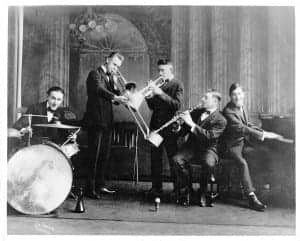Expert Roundtable | February 2017 Hearing Review
Opening riff: 100 years of pushing boundaries in American music
As we commemorate the 100th anniversary of the world’s first jazz recording in 2017, we reflect upon its acoustical impact. Prior to the “Jazz revolution” in the early 20th century, string instruments dominated orchestras for centuries, performing for sashaying dancers in candlelit ballrooms.
That is until the Buddy Bolden Band (1900-1906) created an acoustic revolution in New Orleans by pushing the boundaries of loudness—relegating strings to the rhythm section and creating a “front line” of sound with trombones, clarinets, and his cornet blasting out its dominance (in top photo, Bolden is standing second from left). “The emergence of the jazz band weaned musicians away from conventional written arrangements,” explains Bruce B. Raeburn, PhD, director of the Hogan Jazz Archives at Tulane University and a co-author in this article series. “The standard protocol evolved to improvisation ‘by ear’ and memorization as 5-7 musicians created a big enough sound to replace large orchestras.”
Bolden’s genius was in how he re-shuffled classic New Orleans’ dance hall music to whip the dancers into a frenzy by fusing his own cornet virtuosity, syncopation, and swagger with ragtime, marching band, black gospel, and gut-bucket blues. Raeburn describes the acoustic challenges Bolden had to overcome in large dance halls that were essentially reverb chambers: “One solution was performing on raised platforms,” explains Raeburn, “so that the music maintained its potency while the bodies of the dancers absorbed the excess reverb.”
New Orleans had a long-standing historical tradition of Afro-Caribbean percussion in Congo Square on Sundays, where bells, skulls, rattles, water vessels, and homemade drums produced powerful rhythms. The evolution of the snare and trap drum set also contributed to Jazz’s sonic intensity.
In post Civil War New Orleans, both military and brass bands working for benevolent associations had two drummers playing snare and bass drum with cymbals. Drummers played in the bands that enticed customers from the back of furniture and vegetable wagons that sold their wares door to door, accompanied prize fights, and entertained at store openings, circuses, vaudeville shows, and community fairs. Crafty drummers working in a small space hung a drum from their shoulder with a strap.
As jazz moved into the dance halls in the early 20th century, the number of drummers who could fit on a raised platform had to be cut down for practical reasons—paving the way for innovation. The creation of the snare drum stand and bass drum pedal, and their dissemination in the 1890s, allowed one drummer to play two or more rhythms simultaneously. William F. Ludwig Sr, a German immigrant, percussionist, and founder of the Ludwig Drum Company in Chicago developed and marketed the first bass drum pedal in 1909. By 1916 Ludwig had added snare drums and timpani. As the United States prepared to send troops off to Europe in WWI in 1917, jazz was one of the gifts spread by New Orleans musicians.
Benny Jones, leader of the Treme Brass Band, grew up in New Orleans in the early 1940s as one of the 12 children of Chester Ralph Jones (1913-1984), an influential jazz drummer of the Onward, Tuxedo, and Eureka brass bands, as well as traditional bands at Preservation Hall. “When I was a kid I would always follow the drummer at jazz funerals,” Jones remembers. “Then I’d rush home to practice different kinds of beats.” Chester Jones also taught his son about the need to protect his hearing. “As long as the drummers stay at the back of the band,” Benny recalls him saying, “you have no danger of having your hearing destroyed by the tuba or the trumpet.”
Citation for this article: Bultman BE. Jazz: An acoustical revolution. Hearing Review. 2017;24(2):14.
MORE ARTICLES IN THIS SERIES…
Expert Roundtable: Music & Hearing (February 2017 Hearing Review)
Expert Roundtable: Music & Hearing on the 100th Anniversary of Recorded Jazz, By Marshall Chasin, AuD, Bethany Ewald Bultman, and Dan Beck, Guest-editors
Jazz: An Acoustical Revolution, By Bethany Ewald Bultman
The Evolution of Hearing Conservation Guidelines and Standards in the United States, By Mark Stephenson, PhD
A Historical Perspective on Hearing Protection, By Patricia A. Johnson, AuD
Ear Infections Over the Ages, By Kenneth Einhorn, MD
Promoting Safe Sounds in the Birth City of American Music, By John J. Hutchings, MD, and Bethany Ewald Bultman
Temporary Threshold Shift (TTS) Is NOT So Temporary, By Marshall Chasin, AuD
Have We Really Come That Far? By Dan Beck










